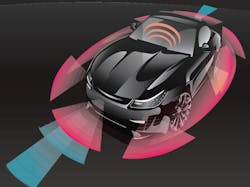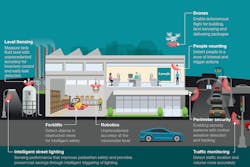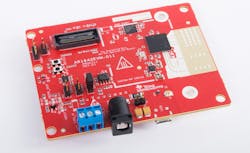Texas Instruments (TI) has been delivering millimeter wave sensors and DSP support for a while but its latest single-chip, mmWave family targets automotive and industrial applications. The 10.4-mm2 chips reduce cost and power requirements while improving reliability and performance. The AWR1x chips address automotive applications like advanced driver-assistance systems (ADAS) and self-driving cars while the IWR1x chips target industrial applications. Systems can run on less than 150 mW. This low-cost solution will significantly change the number and configuration of RADAR sensors in many applications.
Texas Instruments’ mmWave family supports a wide range of industrial applications in addition to automotive applications.
The sensors are designed to accurately sense through a range of materials including plastic, dry wall, clothing, and glass. It has advantages over other sensors like LIDAR because it can operate through environmental conditions such as lighting, rain, dust, fog, and frost.
The mmWave family integrates multiple functions that are typically found in multiple chips. These functions include the transmitter and receiver as well as amplifiers and analog conversion units. An on-chip DSP and microcontroller allows the system to deliver processed information rather than raw data. Applications can provide information from with a 4-centimeter range resolution, range accuracy down to less than 50 micrometers, and a range up to 300 meters.
The hardware and software combination allows designers to create applications that can dynamically adapt from short- to long-range operation. The multi-modal functionality helps to avoid false positives. A system can easily change from long distance to short range operation when a vehicle slows down.
The AWR1x family handles 76- to 81-GHz sensor arrays for sensor and ADAS applications. The single-chip solution allows the creation of very small modules (Fig. 3) that incorporate the chip as well as the transmit and receive antenna arrays.
This photo highlights how small a platform the mmWave family can deliver. The module includes transmit and receive arrays.
TI provides evaluation modules for the chip family (Fig. 4). The mmWave software development kit (SDK) includes sample algorithms and software libraries that only need 20 application programming interfaces (APIs). Developers can get applications up and running in less than 30 minutes. The EVMs are priced at $299.
TI’s AWR1642 EVM is an evaluation platform for mmWave’s automotive chip that works with the mmWave SDK.
The automotive version supports ISO 26262 and enables Automotive safety integrity level (ASIL)-B support. These include the AWR1243, AWR1443, and AWR1642. The AWR1642 includes all components including the DSP and microcontroller. The IWR1443 and IWR1462 are the industrial versions.
About the Author
William G. Wong
Senior Content Director - Electronic Design and Microwaves & RF
I am Editor of Electronic Design focusing on embedded, software, and systems. As Senior Content Director, I also manage Microwaves & RF and I work with a great team of editors to provide engineers, programmers, developers and technical managers with interesting and useful articles and videos on a regular basis. Check out our free newsletters to see the latest content.
You can send press releases for new products for possible coverage on the website. I am also interested in receiving contributed articles for publishing on our website. Use our template and send to me along with a signed release form.
Check out my blog, AltEmbedded on Electronic Design, as well as his latest articles on this site that are listed below.
You can visit my social media via these links:
- AltEmbedded on Electronic Design
- Bill Wong on Facebook
- @AltEmbedded on Twitter
- Bill Wong on LinkedIn
I earned a Bachelor of Electrical Engineering at the Georgia Institute of Technology and a Masters in Computer Science from Rutgers University. I still do a bit of programming using everything from C and C++ to Rust and Ada/SPARK. I do a bit of PHP programming for Drupal websites. I have posted a few Drupal modules.
I still get a hand on software and electronic hardware. Some of this can be found on our Kit Close-Up video series. You can also see me on many of our TechXchange Talk videos. I am interested in a range of projects from robotics to artificial intelligence.




